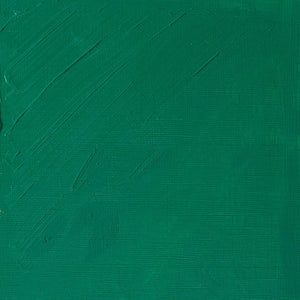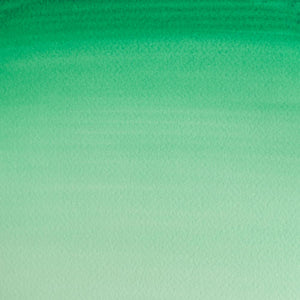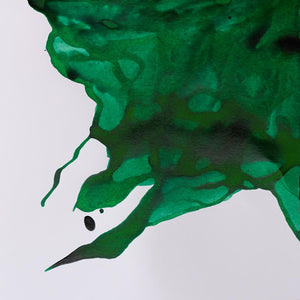
Emerald Green, also known as Schweinfurt Green, Paris Green and Veronese Green, is a bright blue-green named after the precious gemstone. Emerald’s distinctive colour is widely revered, and as such it’s a popular choice for oil and watercolour paintings. However, the pigment once carried a controversial reputation that ultimately proved fatal, owing to one key ingredient: arsenic.
The origins and characteristics of the emerald gemstone
The name emerald derives from the Ancient Greek for ‘green gem’. The emerald gemstone is part of the beryl family, along with aquamarine and morganite. Emerald gets its characteristic colour from trace amounts of chromium and vanadium, and the clarity of the stone is considered almost as important as the colour. Though the colouring of emeralds ranges from a green-dominant yellow-green to a blue-green, it’s only those that are darker in tone that are considered emeralds – otherwise they just go by the name green beryl.

The toxic legacy of Emerald Green pigment in history
Emerald Green as a pigment was commercially produced first by chemists Russ and Sattler in the Bavarian city of Schweinfurt, Germany, in 1814. It was made by mixing and heating copper verdigris with vinegar and white arsenic, then grinding the sediment in linseed oil. Originally pitched as a more robust, lightfast version of Scheele’s Green, the new pigment had a brilliance unlike any other copper green. However, it also had the same tendency to blacken when mixed with sulphur-containing colours such as Cadmium Yellow, Vermillion and Ultramarine. Worse still was the fact that Emerald Green was highly poisonous due to its arsenic content.
When the pigment’s ingredients were disclosed in an 1822 report its toxicity was revealed, yet its widespread use in paints and dye continued. This was probably due to a number of factors: Emerald Green was cheap to produce and highly fashionable, and the colour green was tricky to get right. Though it’s difficult to imagine, arsenic was considered a magical product in the Victorian age, found in many things but especially green dye, and mass-produced and admired by society despite its toxic qualities. It was broadly used not only in the artist’s studio, but in the household – from paints fabrics to patterned wallpapers. When wet, the surfaces of Emerald Green would give off toxic fumes, and so damp clothes or rooms could become death traps: it is believed by many historians that Napoleon’s demise was hastened by the poisonous content of his bathroom wallpaper.

Emerald Green's dark side: The Victorian era's deadly fashion trend
In 1862 The Times newspaper in London published an article written by chemist AW Hoffman about arsenic-laced green titled ‘The dance of death’. Hoffman pointed out that many green dresses and accessories, such as artificial flowers and socks, were full of copper arsenite or copper acetoarsenite. A published sketch soon followed, of a skeleton at a ball requesting a dance with a lady, highlighting just how sought-after the colour was deemed to be – adorning many a high-society ballroom – despite its cost. Even the British Medical Journal wrote that: ‘A lady in full dress, duly decorated with a modern wreath of fifty green leaves, carries on her head forty grains of white arsenic – enough to poison herself and nineteen friends… She actually carries in her skirts poison enough to slay the whole of the admirers she may meet with in half a dozen ball-rooms.’
The resulting effects of the dye were gruesome, causing ulcers and sores along the skin, and when it reached the bloodstream it could cause vomiting, hair loss and organ failure. Life expectancy of those who produced the dye in factories was markedly reduced due to the exposure, and some lost their hands in the process. Examples of Emerald Green Victorian dresses can be found today in museums across the world; their distinctive colouring remains as bright as ever.

Rijksmuseum, CC0, via Wikimedia Common
Emerald Green today
The original Emerald Green pigment was banned in the early 1900s. Despite this, it remained a popular pigment with many artists, from JMW Turner to Renoir, Gauguin to Cézanne and Van Gogh. Emerald Green was central to the palettes of oil on canvas pieces such as Paul Gauguin’s 1888 Arlésiennes (Mistral) and Van Gogh’s La Berceuse, Woman Rocking a Cradle (1851–1930).

Paul Gauguin, Public domain, via Wikimedia Commons [left image]
Vincent van Gogh, CC0, via Wikimedia Commons [right image]
The ideal successor to Emerald Green is Winsor Emerald, which thankfully is chemically stable and safe, posing no health hazards. Winsor Emerald, in our Artists’ Oil Colour range, recreates the same brilliant blue-green impact of the original, without the toxicity. It’s made from the PG36 phthalo green (yellow shade) pigment and PW5 white, rather than the original copper aceto-arsenite –phthalo pigments were introduced in the 1930s and are synthetic pigments from the group of phthalocyanine dyes. It gives a permanent brilliant and clean opaque colour; perfect for achieving vivid scenes, unburdened by a terrible cost.













![WN PWC KAREN KLUGLEIN BOTANICAL SET [FRONT]](http://www.winsornewton.com/cdn/shop/files/136444.jpg?crop=center&v=1740654068&width=20)
![WN PWC KAREN KLUGLEIN BOTANICAL SET [OPEN 2]](http://www.winsornewton.com/cdn/shop/files/136447.jpg?crop=center&v=1740654068&width=20)
![WN PWC ESSENTIAL SET [FRONT]](http://www.winsornewton.com/cdn/shop/files/137583.jpg?crop=center&v=1740762356&width=20)
![WN PWC ESSENTIAL SET [OPEN]](http://www.winsornewton.com/cdn/shop/files/137581.jpg?crop=center&v=1740762356&width=20)
![W&N GALERIA CARDBOARD SET 10X12ML [B014096] 884955097809 [FOP]](http://www.winsornewton.com/cdn/shop/files/138855.jpg?crop=center&v=1740761853&width=20)
![W&N GALERIA CARDBOARD SET 10X12ML 884955097809 [OPEN]](http://www.winsornewton.com/cdn/shop/files/138856.jpg?crop=center&v=1740761853&width=20)

![W&N PROMARKER 24PC STUDENT DESIGNER 884955043295 [FRONT]](http://www.winsornewton.com/cdn/shop/files/78674_d4d78a69-7150-4bf4-a504-3cb5304b0f80.jpg?crop=center&v=1721326116&width=20)

![W&N PROFESSIONAL WATER COLOUR TYRIAN PURPLE [SWATCH]](http://www.winsornewton.com/cdn/shop/files/136113.jpg?crop=center&v=1724423390&width=20)
![W&N WINTON OIL COLOUR [COMPOSITE] 37ML TITANIUM WHITE 094376711653](http://www.winsornewton.com/cdn/shop/files/9238_5073745e-fcfe-4fad-aab4-d631b84e4491.jpg?crop=center&v=1721326117&width=20)
![W&N WINTON OIL COLOUR [SPLODGE] TITANIUM WHITE](http://www.winsornewton.com/cdn/shop/files/131754_19b392ee-9bf6-4caf-a2eb-0356ec1c660a.jpg?crop=center&v=1721326118&width=20)